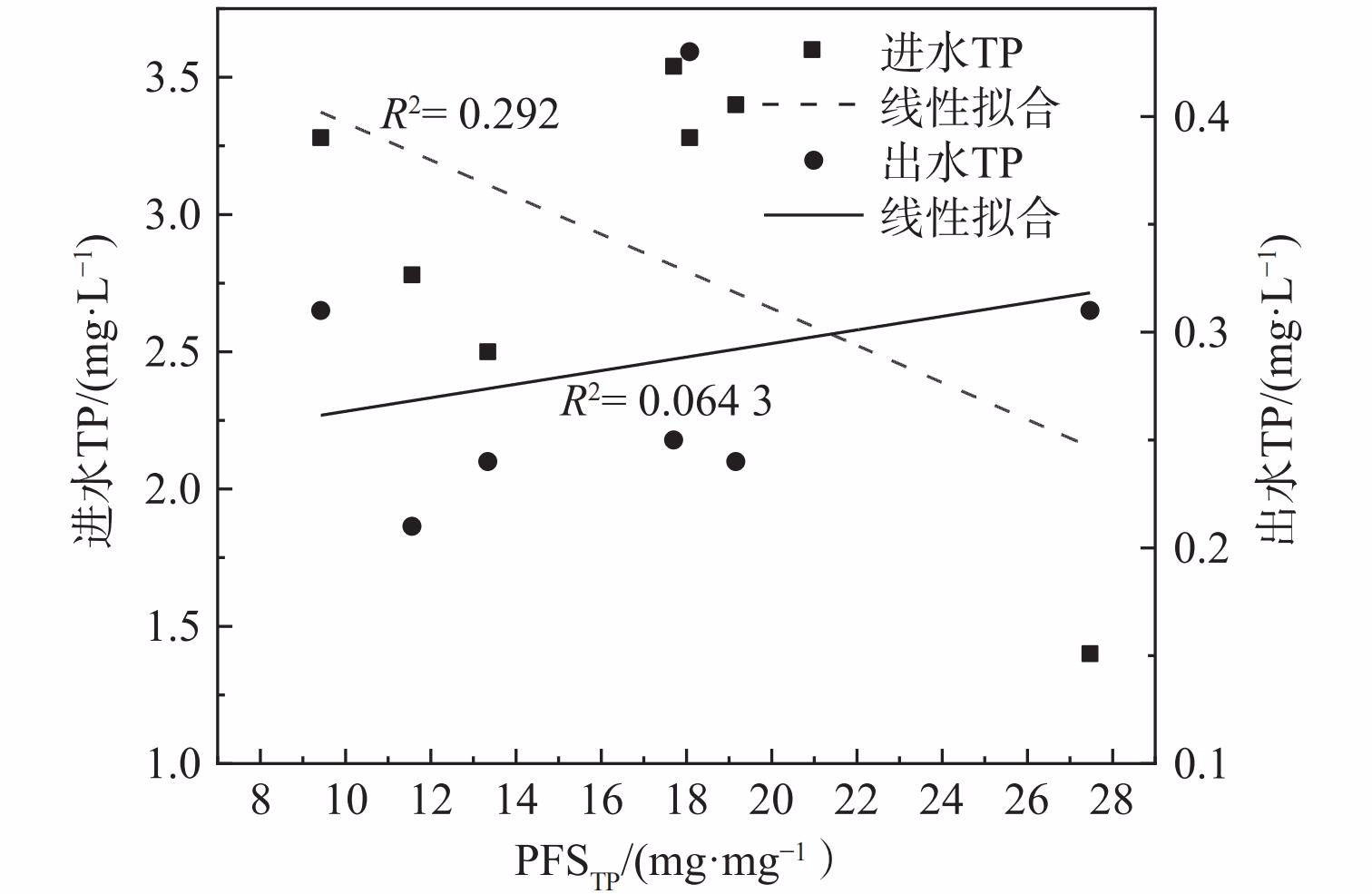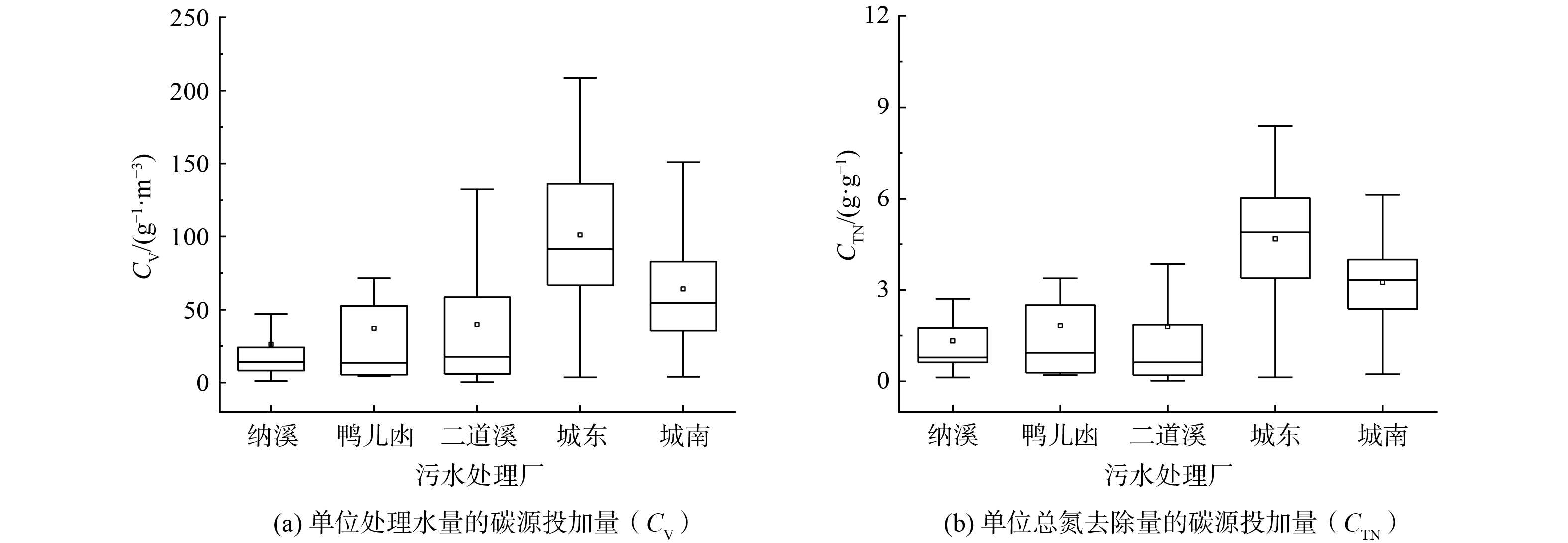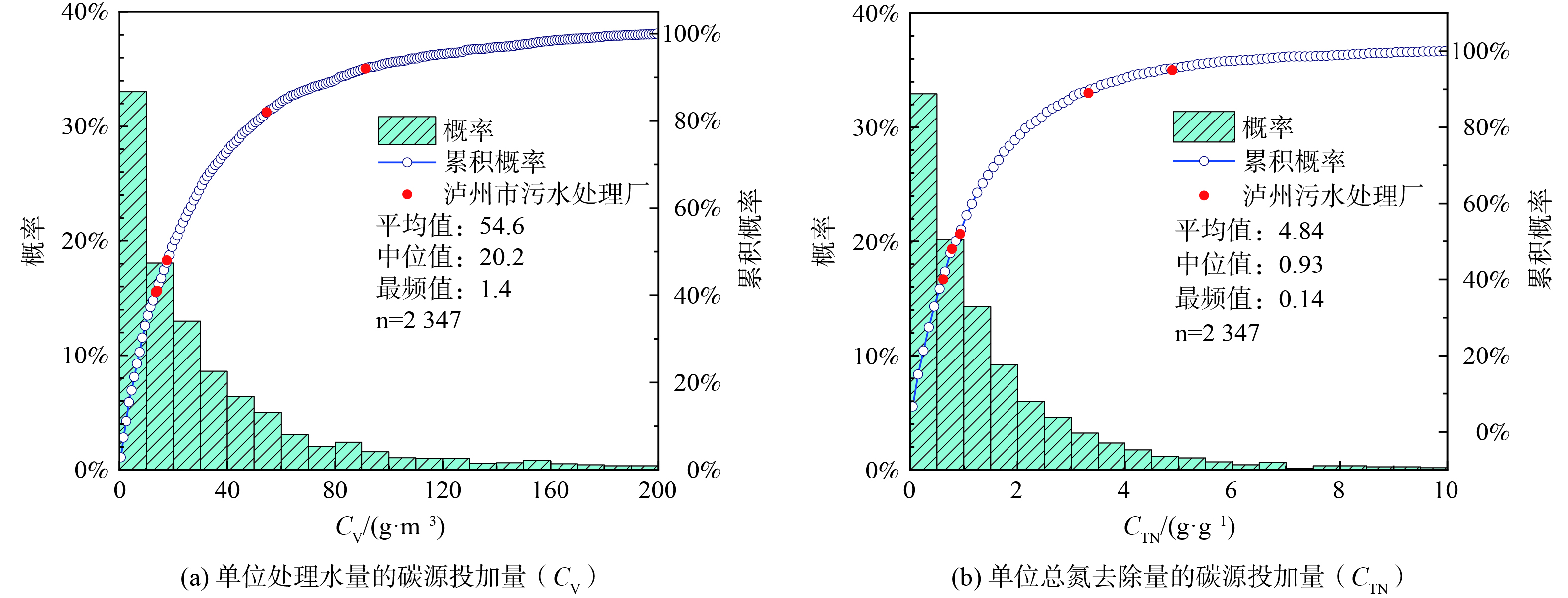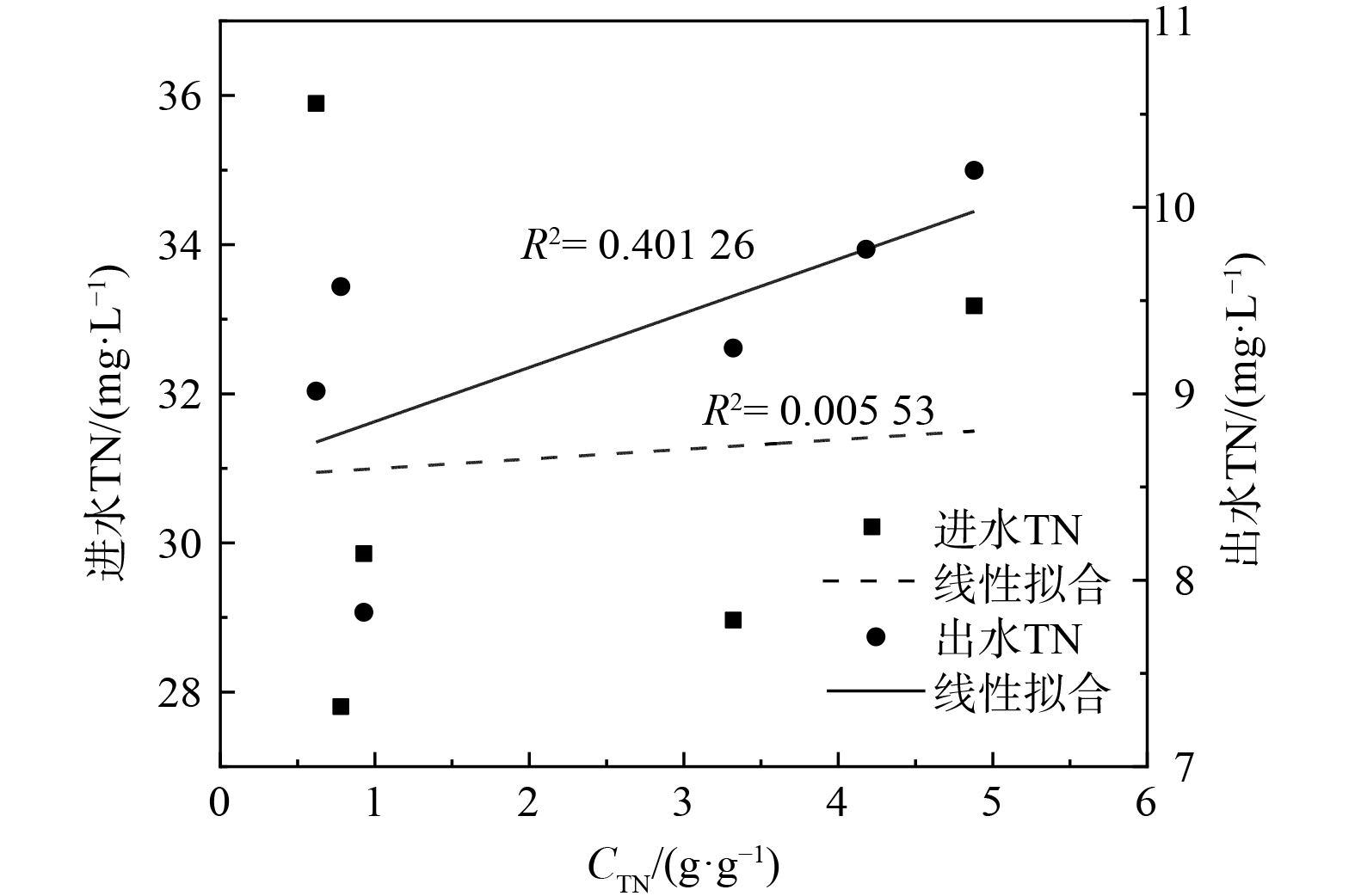-
长江上游地区是我国重要的经济发展带,位于长江上游的中大型城市多以丘陵地貌为主,具有地势落差大、雨污收集速度快、地下水渗入率高等雨污排放特征[1-3]。城市污水处理厂是雨污治理的重要基础设施。一方面,污水处理厂减少了有机污染物、氮磷等污染物的排放,在水环境污染物控制中发挥重要作用[4-6]。城市污水处理厂累计削减的有机污染物 (以COD计) 占全国减排总量的70%以上,且占比逐年增加[7];另一方面,城市污水处理厂需消耗大量电能。污水处理厂的用电量约占全社会用电量的2.6‰[8],且占比逐年上升。此外,城市污水处理厂在深度脱氮除磷中,需使用大量的有机碳源和混凝剂[9-11]。
随着城市污水水量增加和污染物种类增多,污水处理厂面临严峻挑战。为保证出水水质达标,污水处理厂会考虑延长处理工艺单元链和增加了药剂的投加量,致使其运行成本增加[12-13]。本研究拟基于长江上游西南丘陵城市污水处理厂的运行优化需求,以泸州作为长江上游西南丘陵城市的代表,分析2020—2022年泸州中心区城市污水处理厂的电力、混凝剂和碳源使用量和使用效率,并与同期全国城市污水处理厂运行情况比较,以期掌握西南典型丘陵城市污水处理厂的用电量和药剂使用量特征,为污水处理厂运行优化提供参考。
-
本研究中泸州中心区5座城市污水处理厂的运行用电量、药剂投加量和进水与出水水质由泸州市住房和城乡建设局、泸州市兴泸水务 (集团) 股份有限公司提供,全国污水处理厂的运行数据来自住建部全国城镇污水处理管理信息系统和《中国城镇污水处理与再生利用发展报告 (1978-2020) 》。污水处理厂的用电量和药剂投加量为月累积用量;进水和出水水质指标为月均数据;统计期 (2020年1月—2022年4月) 内中位值用于定量讨论水质特征,5th~95th概率分布 (将数据按大小顺序排列的5%和95%分位值) 和箱式图用于表示水质数据分布特征。
-
泸州市位于长江上游丘陵地区,其城市污水和初期雨水经由排水管网进入污水处理厂处理后再排入河流中。该市中心区共有5座城市污水处理厂,依次为纳溪污水处理厂、鸭儿凼污水处理厂、二道溪污水处理厂、城东污水处理厂和城南污水处理厂。5座污水处理厂的设计污水处理量、主体处理工艺和主要耗能单元如表1所示。
-
污水处理厂的处理水量和运行负荷如图1所示。一方面,污水处理厂水量突然升高情况较多,与该地区的降雨频繁密切关联;另一方面,水量随季节性波动明显,二道溪、城东和城南污水处理厂在7—9月份的水量较大[14]。从2021年开始,城南污水处理厂和城东污水处理厂处理水量长期大于设计处理量,主体工艺处于高负荷运行状态。此外,表2展示了5座污水处理厂进出水水质,出水符合《城镇污水处理厂污染物排放标准》 (GB 18918-2002) 一级A排放标准,但距离地表Ⅲ类水相关指标限值尚有一定差距。
-
1) 运行用电量。用电量是污水处理厂的主要运行成本之一,亟需识别西南典型丘陵城市污水处理厂的用电特征和用电效率[15-16]。总用电量 (Q,104 kW·h) 、单位处理水量的用电量 (QV,kW·h·m−3) 和单位污染物去除量的用电量 (QCOD和QNH3-N,分别指去除污水中单位质量有机污染物 (以COD计) 或NH3-N的用电量,kW·h·kg−1) ,常用于表示用电特征和用电效率,计算方法如式 (1)~(3) 。
泸州中心区5座城市污水处理厂的总用电量Q为20.0~110.9 104 kW·h (5th~95th) ,如图2 (a) 所示。鸭儿凼污水处理厂的Q值最大 (中位值105.75 104 kW·h) ,其次为二道溪污水处理厂 (中位值 85.10 104 kW·h) 。城东和城南污水处理厂的处理水量和主体处理工艺相同,但城南污水处理厂Q的中位值为51.01 104 kW·h ,高于城东污水处理厂 (中位值47.61 104 kW·h) 。在污水处理厂的实际运行当中,曝气是主要的耗能工艺。此外,5座城市污水处理厂均在三级处理流程中设置了紫外消毒渠处理单元,这也会增加污水处理厂的总用电量。伴随着污水处理工艺链的延长,电耗的总量和来源也逐渐增加。
泸州中心区5座城市污水处理厂的QV为0.25~0.52 kW·h·m−3 (5th~95th) ,如图2(b)所示。鸭儿凼的QV值最高 (中位值0.46 kW·h·m−3) ,与其膜生物反应器 (membrane bioreactor,MBR) 处理工艺能耗较高有关[17]。城东污水处理厂的QV值最低 (中位值0.28 kW·h·m−3) ,且显著低于城南污水处理厂 (中位值 0.36 kW·h·m−3) 。城东污水处理厂与城南污水处理厂的处理水量相近、工艺相同,QV差异表明进水水质、运营操作等因素会导致用电效率的差异。
泸州中心区城市污水处理厂的QCOD和QNH3-N分别如图2(c)和图2(d)所示。QCOD为1.12~3.55 kW·h·kg−1 (5th~95th) 。其中,鸭儿凼污水处理厂的QCOD最高 (中位值2.58 kW·h·kg−1) ,城东污水处理厂QCOD稍高于城南污水处理厂且分布范围较大 (中位值1.94 kW·h·kg−1) 。QNH3-N为9.64~30.6 kW·h·kg−1 (5th~95th) 。鸭儿凼污水处理厂的QNH3-N最大 (中位值20.57 kW·h·kg−1) ,而城东污水处理厂的QNH3-N最小 (中位值11.23 kW·h·kg−1) ,且显著低于城南污水处理厂 (中位值 17.39 kW·h·kg−1)。
2) 运行用电效率。分析2020—2021年全国5 799座城镇污水处理厂处理用电量 (图3(a)) 。QV为0.16~1.20 kW·h·m−3 (5th~95th) ,中位值和平均值分别为0.36和0.47 kW·h·m−3。80%的污水处理厂的QV低于0.60 kW·h·m−3。此外,泸州中心区5座城市污水处理厂的QV均优于全国平均值,但差于前28%的污水处理厂。其中,鸭儿凼、二道溪和城南污水处理厂的QV差于国内50%以上的污水处理厂。由此说明,泸州中心城区城市污水处理厂的用电效率整体较高,但仍可通过处理工艺优化和升级进一步提高用电效率[18-19]。
泸州是典型的西南丘陵城市。进一步比较其与西南地区和其他地区的用电效率,结果如图3(b)所示。华北地区的QV值最高 (中位值 0.61 kW·h·m−3) ,西南地区、西北地区和华东地区的QV值为中等 (中位值 0.36~0.51 kW·h·m−3) 。东北地区、华中地区和华南地区的QV值最低 (中位值 0.27~0.36 kW·h·m−3) 。与各地区典型运行效率相比,泸州市中心城区5座污水处理厂的QV优于华北地区、西北地区和西南地区的QV。各地区Qv的存在较显著的差异,与污水进水水质、处理工艺和气候紧密关联[20-21]。
为增加运行用电效率,污水处理厂从厂区设计方面应该结合所处的地形特点,在处理单元高程布置中采用合理的布局,以减少提升泵的使用。此外,鼓风机和搅拌器是主要耗能设备,从选购的角度来说,应考虑实际处理水量和水质,选择型号适宜的设备;从布置的角度来说,精准曝气以增加溶解氧的传质速率可提升运行用电效率[22]。
-
1) 除磷混凝剂用量。泸州市中心城区污水处理厂投加的混凝药剂为聚合硫酸铁 (polyferric sulfate,PFS) 。2020—2022年5座城市污水处理厂的单位处理水量的PFS投加量 (PFSV,mg·L−1) 和单位总磷 (TP) 去除量的PFS投加量 (PFSTP,mg·mg−1) 如图4所示。鸭儿凼和二道溪污水处理厂的PFSV较高,为48.42~53.57 mg·L−1;城东和城南污水处理厂的PFSV较低,为25.11~26.98 mg·L−1。
PFSTP与进水和出水水质密切相关。泸州中心城区污水处理厂出水TP均满足一级A排放要求。进一步分析发现,泸州中心城区5座污水处理厂的PFSTP为2.67~30.41 mg·mg−1 (5th~95th) 。城东污水处理厂PFS投加质量分数较低,但同时PFSTP仅为9.41 mg·mg−1;鸭儿凼不仅PFS投加质量分数较高,同时PFSTP达到19.16 mg·mg−1。这与鸭儿凼污水处理厂二级出水的磷形态 (偏磷酸盐或溶解态为主) 等有关,需进一步开展水质分析来提高除磷工艺优化[23-24]。值得注意的是,城东污水处理厂和城南污水处理厂的工艺和设计规模相同,但城南污水处理厂的PFSTP显著较高,为13.34 mg·mg−1。这可能是由于工艺操作和水中磷形态不同。如PFS对偏磷酸盐的去除效果较差,对磷形态分析和操作条件优化将有助于提高除磷效率和混凝剂投加效率[25]。
2) 除磷混凝剂使用效率。比较泸州市中心城区5座污水处理厂与国内其他污水处理厂的混凝剂用量,结果如表3所示。北京市吴家村污水处理厂和上海市城投污水处理厂投加的混凝剂为PFS,但其PFSTP是泸州市中心城区污水处理厂的1.36和2.06倍;昆明市第三污水处理厂投加的混凝剂为聚合氯化铝 (polyaluminium chloride,PAC) ,单位TP去除量的PAC投加量 (PACTP) 为11.1 mg·mg−1。混凝剂使用效率比较结果表明,泸州市中心城区的PFS使用效率较高;由于PFS与PAC的性质差异,混凝剂的处理效率和使用效率存在差异。后续可基于混凝剂的单位除磷效率,进行混凝剂种类、操作条件和投加量等工艺条件优化[26]。污水处理厂的PFSTP与进出水TP关系如表3和图5所示,拟合结果表明其线性相关性较差。这说明污水处理厂的在三级处理化学除磷过程中,混凝剂使用效率PFSTP与进出水TP线性不相关[27]。
-
1) 碳源投加量。为实现高效除氮,污水处理厂通常需要补充外部碳源[30-31]。如图6 (a) 所示,泸州市中心区5座城市污水处理厂单位处理水量的碳源投加量 (CV,折合COD计) 为1.45~161.38 g·m−3 (5th~95th) 。污水处理厂之间CV差别较大,其中纳溪污水处理厂投加的碳源较少 (中位值14.04 g·m−3) ,城东污水处理厂投加的碳源较多 (中位值 96.43 g·m−3) 。污水处理厂的CV差异与进水碳源、形态、污水处理工艺等因素相关。在泸州市的中心区污水处理厂中,单位总氮 (TN) 去除量对应碳源投加量 (CTN,以COD计) 为0.13~6.55 g·g−1 (5th~95th) (图6 (b) )。污水处理厂间的CTN差异规律与CV相似。城东污水处理厂的CTN较高 (中位值为4.88 g·g−1) ,二道溪污水处理厂较低 (中位值为0.60 g·g−1) 。
2) 碳源使用效率。2020年全国2 347座城镇污水处理厂的CV和CTN如图7所示,CV为1.4~154.2 g·m−3 (5th~95th) ,中位值为20.2 g·m−3 (图7(a)) ; CTN为0.04~4.67 g·g−1 (5th~95th) ,中间值为4.84 g·g−1 (图7(b)) 。泸州中心区的5座污水处理厂CV和CTN均差于国内50%以上的污水处理厂,这说明泸州市这5座污水处理厂的碳源使用效率仍有较大提升空间。
为探究碳源使用效率CTN与进出水TN的相关性,对CTN与进出水TN进行线性拟合,结果如图8所示,这说明污水处理厂在外加碳源增强反硝化脱氮过程中,碳源使用效率CTN与进出水TN线性不相关。为提升碳源的使用效率或减少碳源的使用量,可考虑从运行优化、工艺升级与协同两个方面入手。以往污水处理厂投加外加碳源是凭借经验控制投加量,这会导致在维持出水TN达标的情况下,部分碳源可能浪费且增加水体BOD5。而精准加碳可提升碳源的使用效率,可通过对硝酸盐和亚硝酸盐质量浓度的在线监测和反馈调节来实现精准加碳。此外,工艺升级与协同可减少碳源的使用量,采用短程硝化工艺使得氮元素以亚硝酸根的形式存在,进而减少还原过程中的碳源投加量。此外,反硝化滤池工艺的增加和协同不仅可减少碳源在A2/O工艺的投加量,还可维持出水TN稳定性。
-
1) 西南丘陵城市泸州市中心区城市污水处理厂的电力、混凝剂和碳源的用量具有显著季节特征,夏季降雨较多时的用电量和药剂用量较高。2) 在用电量方面,泸州市中心城区污水处理厂的QV为0.25~0.52 kW·h·m−3,用电效率较好,位于全国28%~66%。其中,鸭儿凼污水处理厂的QV较高 (中位值 0.46 kW·h·m−3) ,与其膜生物处理工艺有关。城东和城南污水处理厂的设计处理水量和工艺相同,但QV和QNH3~N差异较大,主要原因为进水中污染物的种类和[NH3-N]差异较大。因此,污水处理厂用电量、用电效率与水量相关,也与进水出水水质、操作条件等相关。3) 在药剂投加量方面,泸州市中心城区污水处理厂以PFS为除磷混凝剂,PFSTP效率较高,为2.67~30.41 mg·mg−1;泸州市中心区城市污水处理厂的碳源使用率较低,位于全国44%~95%,需通过对进水中硝酸盐与亚硝酸盐质量浓度进行监测、升级脱氮工艺和外加碳源精准投加等方式来提升碳源使用效率。
西南丘陵城市泸州中心区城市污水处理厂用电量和药剂投加量特征
Characteristics of electricity consumption and chemical dosage of urban wastewater treatment plants in the central area of the southwestern hilly city Luzhou
-
摘要: 用电量和药剂投加量是城市污水处理厂运行的主要成本,也是污水处理厂减污降碳的重要环节。西南丘陵城市具有地势落差大、雨污收集速度快、地下水渗入率较高等显著区域特征,但其城市污水处理中的电力和药剂使用量和使用效率仍不清楚。分析了西南丘陵城市泸州中心区5座城市污水处理厂电力、混凝剂和碳源的使用量和使用效率。研究发现,电力和药剂使用量具有显著的季节特征,夏季降雨较多时的用电量和药剂用量较高。泸州市中心城区污水处理厂的单位处理水量的用电量为0.28~0.46 kW·h·m−3,位于全国28%~66%;单位总磷去除量的混凝剂用量为25.11~53.57 mg·mg−1,单位总氮去除量的碳源 (折合COD计) 投加量为0.60~4.88 g·g−1,位于全国44%~95%。泸州中心区城市污水处理厂的电力使用效率较高,但碳源使用效率较低,脱氮工艺和操作仍有待优化。本研究可为长江上游地区丘陵城市污水处理厂的优化运行管理和节能降耗工作提供参考。Abstract: Electricity consumption and chemical dosage are major costs in the operation of urban wastewater treatment plants and important aspects of reducing pollution and carbon in wastewater treatment plants. Southwestern hilly cities have significant regional characteristics such as large terrain drop-offs, rapid rainwater collection rates, and high groundwater infiltration rates, but the amount and efficiency of electricity and chemical use in their urban wastewater treatment remains unclear. The usage and efficiency of electricity, coagulant, and carbon source in five urban wastewater treatment plants in the central area of the southwestern hilly city of Luzhou were analyzed in this paper. It was found that electricity consumption and chemical dosage had significant seasonal characteristics, with higher electricity and chemical usage in summer due to more rainfall. The electricity consumption per unit of treated water volume in the central urban wastewater treatment plant in Luzhou ranged from 0.28 to 0.46 kW·h·m−3, located at 28%~66% nationally. The coagulant dosage per unit of total phosphorus removal ranged from 25.11~53.57 mg·mg−1, and the carbon source dosage per unit of total nitrogen removal ranged from 0.60~4.88 g·g−1 (reduced COD value meter), located at 44%~95% nationally. The central area of Luzhou urban wastewater treatment plant had a high efficiency of power utilization but a low efficiency of carbon source utilization, and the denitrification process and operation still needed to be optimized. This study can provide important basic information for the optimal operation and management of urban wastewater treatment plants in hilly cities to save energy and consumption reduction in the upper Yangtze River region.
-
Key words:
- Luzhou City /
- urban wastewater treatment plant /
- electricity consumption /
- coagulant /
- carbon source
-
图 4 泸州中心区城市污水处理厂单位处理水量的PFS投加量 (PFSV) 和单位总磷去除量的PFS投加量 (PFSTP) 时间变化和统计分布 (2020年1月—2022年4月)
Figure 4. Temporal variation and statistical distribution of PFS dosage per unit treated water volume (PFSV) and PFS dosage per unit total phosphorus removal (PFSTP) of urban wastewater treatment plants in the central area of Luzhou (2020-01—2022-04)
表 1 泸州中心区5座城市污水处理厂概况
Table 1. Overview of the five urban wastewater treatment plants in the central area of Luzhou
污水处理厂 设计污水处理量/(104 m3·d−1) 主体处理工艺和主要能耗单元 纳溪污水处理厂 2.75 曝气沉砂池-A2/O改良工艺-紫外消毒渠 鸭儿凼污水处理厂 8.0 曝气沉砂池-MBR-紫外消毒渠 二道溪污水处理厂 10.0 曝气沉砂池-A2/O-反硝化滤池-紫外消毒渠 城东污水处理厂 5.0 曝气沉砂池-A2/O改良工艺-D型滤池-紫外消毒渠 城南污水处理厂 5.0 曝气沉砂池-A2/O改良工艺-D型滤池-紫外消毒渠 注:A2/O改良工艺即在厌氧池前端增加了预反硝化单元。 表 2 泸州中心区城市污水处理厂进水和出水水质特征 (2020年1月—2022年4月)
Table 2. Quality characteristics of inlet and outlet water of urban wastewater treatment plants in the central area of Luzhou (2020-01—2022-04)
污水 处理厂 BOD5/(mg·L−1) TN/(mg·L−1) [NH3-N]/(mg·L−1) TP/(mg·L−1) 进水 出水 进水 出水 进水 出水 进水 出水 纳溪污水处理厂 198.47±60.79 12.03±3.87 27.80±6.67 9.57±1.10 18.70±5.72 0.61±0.45 2.79±0.72 0.21±0.06 鸭儿凼污水处理厂 197.01±55.66 11.77±1.79 29.85±5.18 7.83±1.54 23.21±2.95 0.51±0.32 3.40±1.01 0.24±0.06 二道溪污水处理厂 231.52±55.01 11.26±2.61 29.85±5.18 7.83±1.54 28.39±9.40 0.04±0.39 3.54±0.85 0.25±0.09 城东污水处理厂 182.33±78.28 19.86±3.55 33.18±8.68 10.20±1.21 25.69±6.69 0.04±0.28 3.28±1.08 0.31±0.03 城南污水处理厂 216.65±65.50 11.97±2.99 28.97±7.55 9.25±1.49 20.73±6.04 0.03±0.03 2.50±0.77 0.24±0.07 表 3 典型城市污水厂处理厂混凝剂药耗水平
Table 3. Coagulant consumption level in a typical urban wastewater treatment plants
-
[1] 翁异静, 周祥祥, 陈思静. 长江经济带经济高质量发展差异性机理及对策分析[J]. 资源开发与市场, 2022, 38(2): 186-193. doi: 10.3969/j.issn.1005-8141.2022.02.009 [2] 刘冬, 杨悦, 邹长新. 长江经济带大保护战略下长江上游生态屏障建设的思考[J]. 环境保护, 2019, 47(18): 22-25. doi: 10.14026/j.cnki.0253-9705.2019.18.004 [3] 魏山忠. 落实长江大保护方针 为长江经济带发展提供水利支撑与保障[J]. 长江技术经济, 2017, 1(1): 8-12. [4] 易倩文, 肖芳, 李江, 等. 贵阳市典型污水处理厂新污染物的赋存、去除及归趋[J/OL]. 环境科学学报: 1-12 [2023-05-17]. [5] 王启镔, 李浩, 董旭, 等. 改良型A2/O污水处理厂的工艺优化调控方案及其对同步脱氮除磷效率的提升[J]. 环境工程学报, 2022, 16(2): 659-665. doi: 10.12030/j.cjee.202101059 [6] 王瑞霖, 张洪良, 张功良, 等. 基于污水处理厂提标改造需求的难降解工业废水处理工艺改进——以湖南省某城镇污水处理厂为例[J]. 环境工程学报, 2021, 15(11): 3781-3788. doi: 10.12030/j.cjee.202103199 [7] 宋连朋, 魏连雨, 赵乐军, 等. 我国城镇污水处理厂建设运行现状及存在问题分析[J]. 给水排水, 2013, 49(3): 39-44. doi: 10.3969/j.issn.1002-8471.2013.03.008 [8] 中国国家能源局-2022年全社会用电量[EB/OL] 3-01-18]. http://www.nea.gov.cn/2023-01/18/c_1310691508.htm.
[9] 张雪. 污水处理厂低碳节能的探讨与研究[J]. 建材发展导向, 2022, 20(24): 196-198. doi: 10.16673/j.cnki.jcfzdx.2022.0337 [10] OWODUNNI A A, ISMAIL S, KURNIAWAN S B, et al. A review on revolutionary technique for phosphate removal in wastewater using green coagulant[J]. Journal of Water Process Engineering, 2023, 52: 103573. doi: 10.1016/j.jwpe.2023.103573 [11] IWUOZOR KO. Prospects and challenges of using coagulation-flocculation method in the treatment of effluents[J]. Advanced Journal of Chemistry-Section A, 2019, 2(2): 105-127. [12] 周华, 何梓灏, 夏海波, 等. 关于城镇生活污水处理厂再提标的思考[J]. 给水排水, 2021, 57(10): 52-5. doi: 10.13789/j.cnki.wwe1964.2021.10.009 [13] 张安龙, 高楚玥, 王先宝, 等. 某城镇污水处理厂能耗调研与节能分析[J]. 给水排水, 2020, 56(S1): 459-464. doi: 10.13789/j.cnki.wwe1964.2020.S1.106 [14] 陈玮, 程彩霞, 徐慧纬, 等. 合流制管网截流雨水对城镇污水处理厂处理效能影响分析[J]. 给水排水, 2017, 53(10): 36-40. doi: 10.3969/j.issn.1002-8471.2017.10.009 [15] 陈宏儒. 城市污水处理厂能耗评价及节能途径研究[D]. 西安: 西安建筑科技大学, 2009. [16] LIU Y, NGO H H, GUO W, et al. The roles of free ammonia (FA) in biological wastewater treatment processes: A review. Environment International[J]. 2019, 123: 9-10. [17] 李喆, 赵乐军, 朱慧芳, 等. 我国城镇污水处理厂建设运行概况及存在问题分析[J]. 给水排水, 2018, 54(4): 52-57. doi: 10.3969/j.issn.1002-8471.2018.04.010 [18] 张显忠, 程俊, 徐波. 基于低碳节能的城镇污水处理厂MBR工艺设计要点[J]. 中国市政工程, 2023(1): 36-40. doi: 10.3969/j.issn.1004-4655.2023.01.011 [19] 周政, 李怀波, 王燕, 等. 低碳氮比进水AAO污水处理厂碳排放特征及低碳运行研究[J/OL]. 中国环境科学: 1-14.[2023-05-17] [20] 周海蔚, 龙向宇, 唐然, 等. 温度与碳源类型对生物除磷性能和污泥沉降性能的影响[J]. 当代化工, 2022, 51(8): 1765-1772. doi: 10.3969/j.issn.1671-0460.2022.08.001 [21] 田文清, 俞小军, 邓颖, 等. 基于磷回收的低温微氧EBPR系统的表观与微观特性[J]. 中国环境科学, 2022, 42(4): 1625-1634. doi: 10.3969/j.issn.1000-6923.2022.04.016 [22] 焦煜涵. 城市污水处理厂能耗影响因素分析及节能环保措施研究[D]. 西安: 西北大学, 2020. [23] 郑晓英, 李楠, 邱丽佳, 等. 城市污水处理厂二级处理出水中磷深度去除技术[J]. 环境工程学报, 2019, 13(8): 1839-1846. doi: 10.12030/j.cjee.201811003 [24] 刘赛, 宋威. 大型生活污水处理厂高效澄清池工艺调试研究[J]. 给水排水, 2022, 58(S1): 164-169. doi: 10.13789/j.cnki.wwe1964.2021.03.23.0005 [25] 王晓勇, 王立勇, 刘立华. 聚合硫酸铁在污水除磷中的使用及效益分析[J]. 科技与创新, 2021(15): 70-71. doi: 10.15913/j.cnki.kjycx.2021.15.030 [26] 黄俊熙, 岑玉铭, 关宇霆, 等. 污水处理过程中除磷加药智能控制系统及应用研究[J]. 中国给水排水, 2022, 38(1): 104-107. doi: 10.19853/j.zgjsps.1000-4602.2022.01.016 [27] 王众众, 吴光学, 孙迎雪, 等. 污水深度处理微絮凝-V型滤池工艺运行性能分析[J]. 给水排水, 2013, 49(9): 52-56. doi: 10.3969/j.issn.1002-8471.2013.09.011 [28] 马伟芳, 郭浩, 姜杰, 等. 城市污水厂化学除磷精确控制技术研究与工程示范[J]. 中国给水排水, 2014, 30(5): 92-95. doi: 10.19853/j.zgjsps.1000-4602.2014.05.028 [29] 陈广. 城镇污水处理厂化学除磷研究[J]. 中国市政工程, 2015(3): 33-35. doi: 10.3969/j.issn.1004-4655.2015.03.010 [30] FU X, HOU R, YANG P, et al. Application of external carbon source in heterotrophic denitrification of domestic sewage: A review[J]. Science of The Total Environment, 2022: 153061. [31] ZHANG F, MA C, HUANG X, et al. Research progress in solid carbon source–based denitrification technologies for different target water bodies[J]. Science of the Total Environment, 2021, 782: 146669. doi: 10.1016/j.scitotenv.2021.146669 -




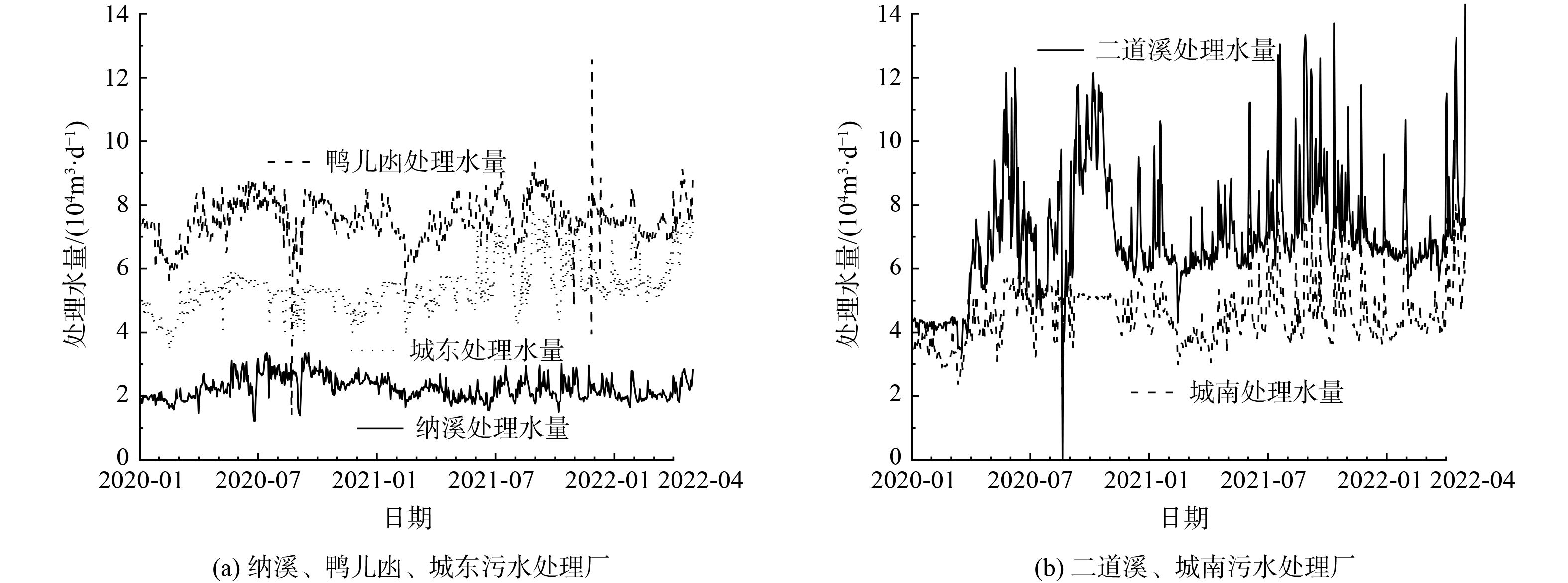
 下载:
下载:



